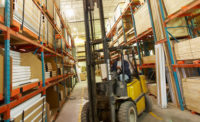America’s solar energy industry has grown rapidly — more than doubling its workforce. There are now more than 242,000 U.S. solar workers. Training programs and compliance with OSHA safety standards keep workers informed and can prevent accidents.
Solar energy is a growing industry, but the hazards workers face are not unique. Still, many solar energy standards are only now being written and developed, 30 to 40 years after the industry was first established. OSHA is leading the charge and has many standards that solar companies should reference when establishing best practices to safeguard against hazards.
Minimizing human error
Human error accounts for a significant percentage of accidents across all industries, including solar. Cramming too many wires into an electrical box, creating a cluttered work area that is not up to code, not following equipment standards and inadequate instructions on labeling and signage are among the most common errors that can lead to injuries.
Solar companies should monitor frequently for new standards and adjust their best practices and training programs as needed to ensure that their employees are well-versed in the most up-to-date procedures and working in compliance with them.
Use of industrial safety identification in the form of safety labels and site safety signage is a key way to prevent human error and alert workers to possible hazards. Continuing safety training programs and OSHA-compliant industrial safety identification serve as easily accessible references for best practices.
Protecting against electrical hazards
Arc flash burn is a common electrical hazard caused by an arc fault, or electrical explosion. Arc flash burn refers to the light and heat produced by the fault, and it can be fatal. Solar workers are particularly at risk of experiencing arc flash burn when attaching panels to an electric circuit.
Arc faults also commonly occur at junction boxes for a multitude of reasons. Turning the boxes on or off or changing the direction of the flow of power inside the boxes can trigger faults. Additional causes include wiring failures, excessive DC current, overheating, lack of or improper grounding, improper connectors and even rodent infestations.
To keep workers safe, electrical equipment and surrounding areas should be thoroughly labeled with durable, weather and fade resistant warning labels, and clear procedures should be posted to avoid arc fault and other hazards.
Industrial safety identification signage alerts workers to be mindful of overhead power lines and maintain a buffer of at least 10 ft at all times to avoid electrocution or burns. Falls from this height may be deadly, so it is vital to ensure workers are aware of these serious conditions. All industrial safety identification should be made to resist fading and product disintegration.
Maintaining equipment
Servicing equipment regularly is another critical way to prevent electrical accidents by ensuring the equipment is clean and working properly. Maintenance, repair and operations should be a cornerstone of companies’ safety agendas. To safeguard against them, businesses should implement a lockout tagout program.
Designed to protect workers from the release of hazardous energy during servicing, the program is estimated to prevent more than 50,000 injuries and fatalities every year. Employees performing maintenance first deactivate and then “lockout tagout” equipment so that no one else can access and reactivate it. This program prevents accidental equipment activation and can prevent serious injury.
When purchasing lockout tagout tags, companies should consider quality and durability as well as for which kinds of equipment the tags will be used. Tags can be made from many different materials and can be designed for one time use or repeated use. Vinyl tag construction is the most durable.
Sources:
- By Tim O’Connor, VP of sales, LEM Products Inc.
- Solar Power World



